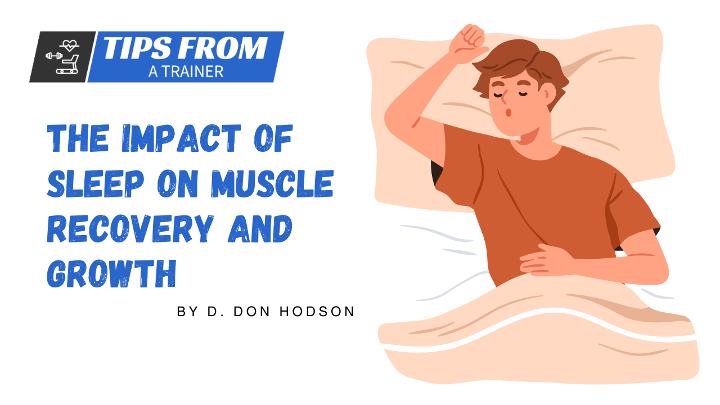Introduction
In the intricate tapestry of human health and performance, sleep stands as a cornerstone often overshadowed by its more conspicuous counterparts: diet, exercise, and hydration. Yet, within the realm of sleep, a profound narrative unfolds—a narrative where seemingly dormant hours of rest orchestrate a symphony of restoration, renewal, and growth. It is here, in the tranquil realm of slumber, that the stage is set for the compelling interplay between sleep and the spheres of muscle recovery and growth to unfurl.
For athletes, fitness aficionados, and anyone engaged in physical activities, the pursuit of optimal performance is not merely a goal; it is an enduring journey marked by sweat, dedication, and a ceaseless commitment to progress. A pivotal chapter within this narrative is the story of muscle recovery and growth—a narrative where the body's resilience is tested, and the potential for growth is cultivated. Whether it's the athlete striving for faster sprints, the weightlifter pushing for higher weights, or the individual pursuing a healthier lifestyle, the integral role of muscle recovery and growth is etched deeply into their pursuits.
Yet, amid the cacophony of protein shakes, training regimens, and nutritional calculations, one ally often overlooked stands silently on the sidelines—sleep. Sleep, that precious and often elusive commodity, emerges not merely as a respite from the demands of the day, but as an active participant in the saga of recovery and growth. As the body rests, a complex symphony of physiological processes unfurls—an intricate dance where tissues mend, hormones surge, and the seeds of future progress are sown.
The pursuit of physical excellence demands a holistic perspective—one that weaves the threads of various components into a coherent tapestry. While exercise forms the foundation for muscular development, and nutrition provides the bricks for reconstruction, sleep emerges as the mortar binding these elements together. In this intricate tapestry, sleep is the unsung hero—the conductor orchestrating the harmonious union of effort, nutrition, and recovery.
Against this backdrop, the objective of this article comes into focus: to meticulously explore the symbiotic relationship between sleep, muscle recovery, and growth. It seeks to unveil the science underpinning this triad, to demystify the mechanisms through which sleep nurtures recovery, and to underscore the profound implications for those embarking on journeys of fitness and physical prowess. As we delve into the depths of this exploration, a world of intricate processes, hormonal symphonies, and cellular rejuvenation unfolds—a world that serves as a testament to the awe-inspiring capabilities of the human body and the role that sleep plays in nurturing its potential.
From the early theories of recovery to the latest findings in sleep science, from practical strategies to optimize sleep to the far-reaching impacts of sleep deprivation, this article endeavors to paint a comprehensive portrait of the intimate connection between sleep, muscle recovery, and growth. As we traverse this landscape of science and practical wisdom, we invite you to embark on a journey that unveils the transformative power of sleep—a journey that invites you to harness the remarkable capacities of your body, embrace the rhythms of rest, and ultimately, embark on a trajectory of holistic well-being and unparalleled performance.
Table of Contents
Introduction
Understanding Muscle Recovery and Growth
The Science Behind Sleep and Muscle Recovery
Sleep Duration and Muscle Recovery
Quality of Sleep and Muscle Recovery
The Interplay Between Sleep, Nutrition, and Muscle Growth
Practical Strategies for Enhancing Sleep and Muscle Recovery
Conclusion

Understanding Muscle Recovery and Growth
To truly grasp the profound influence of sleep on muscle recovery and growth, a comprehensive understanding of these concepts within the context of physical fitness is essential. Muscle recovery represents a meticulously intricate process through which muscle tissues engage in self-repair subsequent to the stress and exertion induced by exercise. Within this recovery mechanism lies the restoration of impaired muscle fibers and the intricate synthesis of proteins indispensable for the robustness of muscles. Concurrently, the phenomenon of muscle growth, scientifically known as hypertrophy, stems from the adaptive response of muscles to the taxing load and strain encountered during workout sessions.
The dynamics of muscle recovery and growth constitute intricate processes that are subject to the influence of multiple factors, notably including appropriate nutrition, hydration, and a particularly critical ingredient: rest. The exertion of exercise on muscle fibers results in minuscule yet consequential micro-tears that demand meticulous repair. This intricate mending process subsequently culminates in muscle growth, imparting increased resilience to muscle fibers and amplifying their capacity to withstand forthcoming challenges and stresses.
The Science Behind Sleep and Muscle Recovery
Sleep, often referred to as the body's innate recalibration mechanism, occupies a pivotal role in steering the course of muscle recovery and growth. The sleep cycle itself is a multi-faceted phenomenon characterized by distinctive stages, prominently categorized into the realms of NREM (Non-Rapid Eye Movement) and REM (Rapid Eye Movement) sleep. It is within the domain of NREM sleep, particularly during its deep stages, that the foundation for physical rejuvenation is meticulously laid. During these phases, the body orchestrates the release of growth hormone—a potent catalyst for the reparation and recuperation of muscles. Furthermore, it is within the embrace of NREM sleep that cellular regeneration and the mending of marred tissues unfold, unequivocally positioning it as a critical contributor to the intricacies of muscle rejuvenation.
While REM sleep predominantly finds its recognition in cognitive processes and emotional equilibrium, its indirect support to the narrative of muscle recovery is undeniable. A well-rested mental landscape renders contributions towards diminished stress and cortisol levels—forces that if left unchecked can pose as deterrents to the progression of muscle recovery. The seamless interplay between the alternating cycles of NREM and REM sleep impeccably choreographs a symphony of both physical and mental renewal, nurturing the body's innate capability to mend and flourish.
Sleep Duration and Muscle Recovery
A cardinal tenet that demands unwavering emphasis in the discourse of muscle recovery and growth is none other than the duration of sleep. Within this facet, divergent age groups stand as constituents with distinct sleep requisites. However, for the demographic of adults, the recommended range of 7 to 9 hours of sleep per night emerges as an incontrovertible cornerstone. This cardinal figure is intrinsically intertwined with the sustenance of an efficacious realm of muscle recovery and growth. As an evolving tapestry of research continues to be woven, the threads of evidence are braided together, illuminating a resolute correlation between insufficient sleep duration and the unraveling of muscle recovery and growth. Manifested through diminished muscle protein synthesis, the ramifications of sleep deprivation echo far and wide, casting shadows upon the body's competence to holistically mend and construct muscle tissues.
Yet, the conundrum posed by consistently subpar sleep transcends mere diminishment of muscle recovery—it stretches its reach towards the arena of elevated risks. Overtraining emerges as an ominous specter, a consequence of inadequate sleep that potently portends a landscape of increased susceptibility to injuries. The intricate balance of hormones is intrinsically disrupted, ushering in elevated cortisol levels—a harbinger of muscle catabolism. The immune fortifications also bear the brunt of insufficient sleep, leaving the fortress vulnerable to external intrusions, thereby further exacerbating the impediments to the recovery process.
Quality of Sleep and Muscle Recovery
While the spotlight often falls on sleep duration, the quality of sleep stands as an equally formidable force influencing the symphony of muscle recovery and growth. This dimension resonates with the qualitative aspects of sleep—think of it as a dynamic tapestry woven from the fabric of uninterrupted slumber and the absence of sleep disturbances. The intricate harmony of sleep can be disrupted by a myriad of factors, ranging from transient interruptions to chronic sleep disorders, and in doing so, it can cast its shadow upon the tapestry of muscle recovery.
The realm of hormonal regulation, a landscape where the ebb and flow of biochemical signals orchestrate the body's intricate dance, is exquisitely sensitive to the nuances of sleep quality. The disruption of sleep quality unfurls as a catalyst for the elevation of cortisol levels—an eventuality that orchestrates an environment inimical to muscle recovery and growth. Deep sleep, celebrated under the nomenclature of slow-wave sleep, takes center stage as an influential player in the theater of muscle repair and growth. Within its realm, the orchestration of efficient recovery mechanisms is unbridled, aligning with the broader narrative of muscular rejuvenation.
In a bid to augment the fabric of sleep quality, practical measures beckon individuals towards the creation of sleep-conducive environments and bedtime rituals. These rituals act as ethereal hands that guide the body towards a state of relaxation, signaling to the body that the time for rest has arrived. Embracing strategies that minimize exposure to the insidious blue light emanating from screens before sleep takes the form of a pivotal intervention. By heeding this call, the production of melatonin—a hormone that gently cradles the body into slumber—is unimpeded, setting the stage for an uninterrupted journey into the realm of sleep.
The Interplay Between Sleep, Nutrition, and Muscle Growth
The choreography of sleep and its profound resonance with nutrition paints a vivid tapestry that elucidates the multifaceted tapestry of influences underpinning muscle recovery and growth. Sleep deprivation, akin to a tempestuous force, can throw appetite-regulating hormones into disarray, beckoning individuals towards ill-advised dietary choices that unfurl as stumbling blocks to the overarching goal of recovery. The ebullient presence of adequate sleep surfaces as a masterful conductor in the orchestra of metabolic harmony, steering the body's ability to finely regulate the dance of hunger and satiety. This modulation, in turn, weaves its influence over the broader narrative of consumption patterns, furnishing a nurturing environment for healthier dietary habits to take root and flourish.
The aftermath of a workout stands as a pivotal juncture where sleep and nutrition converge in harmonious unity. The ritual of post-workout nutrition, the strategic intake of essential nutrients after the cessation of exercise, forges an intricate bond with sleep, forging a potent alliance in the quest for optimal recovery. A meticulously balanced meal—imbued with a symphony of proteins and a symposium of nutrients—emerges as the foundation upon which the architecture of muscle repair and growth is meticulously constructed. Among the ranks of these nutritional constituents, protein occupies a central throne. It is the bearer of amino acids—the elemental bricks in the edifice of new muscle proteins—bestowing upon it a pivotal role in shepherding forth the march of recovery and growth.
Practical Strategies for Enhancing Sleep and Muscle Recovery
As the overture of optimizing sleep reverberates, the stage is set for the unveiling of practical strategies that possess the potential to be the harbingers of transformative change in the realm of muscle recovery and growth. Central to this endeavor is the establishment of a harmonious cadence, a rhythm that manifests as a consistent sleep schedule. A daily pilgrimage to the realm of slumber, embarked upon and concluded at consistent hours, orchestrates a symphony of regulated sleep cycles. This measured cadence, in turn, dances in harmony with the body's internal circadian rhythms, contributing to the delicate calibration of sleep quality.
The fabric of sleep's canvas unfurls further as the realm of relaxation techniques is unveiled. Techniques such as the art of deep breathing, meditation, and gentle stretching emerge as the lighthouses guiding the body towards the tranquil shores of restful sleep. The practice of these techniques crafts a sanctuary for relaxation, an environment in which stressors retreat, and the mind embraces a serenity that propels it towards the domains of slumber. An equally vital intervention beckons in the form of a digital detox before bedtime. The emanations of blue light—discharged from the screens of electronic devices—stand as a formidable adversary to the hormone of sleep, melatonin. By heeding this clarion call, an atmosphere conducive to melatonin's uninhibited release is tenderly nurtured, paving the way for an uninterrupted voyage into the realms of restorative sleep.
In the realm of fitness and beyond, the symbiotic dance between sleep, muscle recovery, and growth unveils its transformative potential. The potency of this trifecta casts a profound echo—a reminder that in the quiet moments of slumber, a silent symphony of restoration and renewal unfolds, underscoring the inherent capacity of the body to mend, regenerate, and thrive.
Conclusion
As we draw the curtains on this exploration of the profound relationship between sleep, muscle recovery, and growth, we are left with a resounding appreciation for the intricate web of processes that govern our bodies. The significance of sleep in the context of physical well-being is no longer relegated to the realm of mere rest; it emerges as a dynamic force, a conductor orchestrating the harmonious symphony of recovery and growth.
From the earliest stages of human inquiry, when the mysteries of rejuvenation were shrouded in enigma, to the modern scientific revelations that illuminate the intricate dance of hormones, cells, and neural pathways, one resounding truth reverberates—sleep is the silent architect of transformation. It is in the hushed moments of slumber that the blueprint for muscle recovery and growth is meticulously executed.
Amid the hustle and bustle of modern life, where commitments and obligations often crowd the stage, it is tempting to view sleep as a negotiable luxury. Yet, the tapestry woven by science and experience alike paints a different narrative—one where sleep is not a negotiable commodity, but a non-negotiable foundation for unlocking the full potential of our physical endeavors.
For the athlete striving for peak performance, sleep is the secret weapon that enhances endurance, sharpens focus, and safeguards against overtraining. For the dedicated fitness enthusiast sculpting their physique, sleep is the master sculptor that fashions lean muscle and chisels strength. For the everyday individual seeking vitality and well-being, sleep is the unwavering companion that fortifies the body, calms the mind, and nurtures holistic health.
As the curtain falls, it is worth reflecting on the magnitude of our bodies' resilience and adaptability. The process of muscle recovery and growth is a testament to the extraordinary capabilities of the human form—a symphony of cells, hormones, and energy converging to shape a stronger self. And in this grand symphony, sleep assumes its rightful place as the maestro, guiding each note and tempo, ensuring harmony and balance.
So, as you navigate the path of your fitness journey, remember the untold power that lies within the realm of sleep. As you lace up your shoes for another workout, as you savor a nutrient-rich meal, let the sanctity of sleep be the foundation upon which you build your physical aspirations. Embrace sleep not merely as a reprieve from the demands of the day, but as a partner in progress—a partner that labors tirelessly, behind the scenes, to ensure that your efforts are rewarded, your muscles thrive, and your goals are realized.
In this synergy of science and practical wisdom, as sleep and muscle recovery converge, we find a profound invitation—a call to honor the rhythms of rest, to embrace sleep as an ally in our pursuit of excellence, and to craft a narrative where each night's slumber paves the way for a stronger, healthier, and more vibrant tomorrow.

Don Hodson, Certified Personal Trainer
I'm Don, an ACE-certified personal trainer and the founder of Tips From A Trainer. With my passion for fitness and years of experience, I've helped countless individuals transform their physiques!
Having personally overcome weight challenges throughout my life, I understand the struggle. Through consistency, exercise, and a balanced diet, I have managed to stay in shape and I want to share my message with the world!
The fitness industry is fraught with misconceptions and deceptive practices, which is why I am committed to providing you with the truth.
- My Site: www.Don-Hodson.com
- My Company: www.ConnectedAgeMarketing.com

The Impact of Sleep on Muscle Recovery and Growth